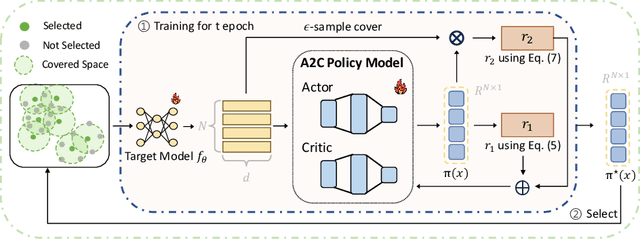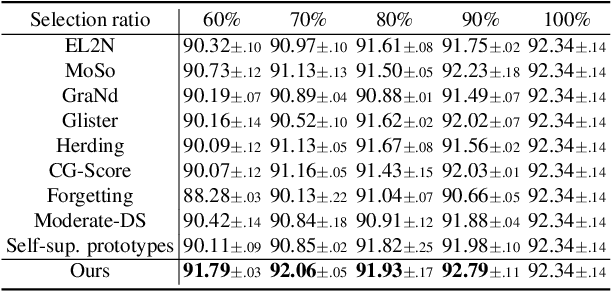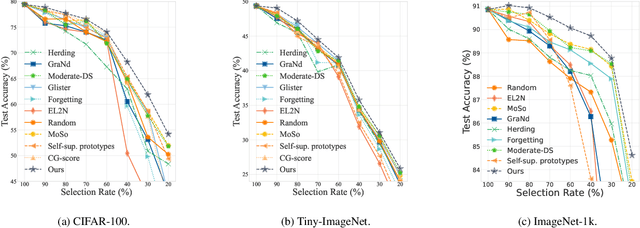Jian Zhao
School of Electronic Science and Engineering, Nanjing University
The Tool Decathlon: Benchmarking Language Agents for Diverse, Realistic, and Long-Horizon Task Execution
Oct 29, 2025Abstract:Real-world language agents must handle complex, multi-step workflows across diverse Apps. For instance, an agent may manage emails by coordinating with calendars and file systems, or monitor a production database to detect anomalies and generate reports following an operating manual. However, existing language agent benchmarks often focus on narrow domains or simplified tasks that lack the diversity, realism, and long-horizon complexity required to evaluate agents' real-world performance. To address this gap, we introduce the Tool Decathlon (dubbed as Toolathlon), a benchmark for language agents offering diverse Apps and tools, realistic environment setup, and reliable execution-based evaluation. Toolathlon spans 32 software applications and 604 tools, ranging from everyday platforms such as Google Calendar and Notion to professional ones like WooCommerce, Kubernetes, and BigQuery. Most of the tools are based on a high-quality set of Model Context Protocol (MCP) servers that we may have revised or implemented ourselves. Unlike prior works, which primarily ensure functional realism but offer limited environment state diversity, we provide realistic initial environment states from real software, such as Canvas courses with dozens of students or real financial spreadsheets. This benchmark includes 108 manually sourced or crafted tasks in total, requiring interacting with multiple Apps over around 20 turns on average to complete. Each task is strictly verifiable through dedicated evaluation scripts. Comprehensive evaluation of SOTA models highlights their significant shortcomings: the best-performing model, Claude-4.5-Sonnet, achieves only a 38.6% success rate with 20.2 tool calling turns on average, while the top open-weights model DeepSeek-V3.2-Exp reaches 20.1%. We expect Toolathlon to drive the development of more capable language agents for real-world, long-horizon task execution.
Attention as a Compass: Efficient Exploration for Process-Supervised RL in Reasoning Models
Sep 30, 2025Abstract:Reinforcement Learning (RL) has shown remarkable success in enhancing the reasoning capabilities of Large Language Models (LLMs). Process-Supervised RL (PSRL) has emerged as a more effective paradigm compared to outcome-based RL. However, existing PSRL approaches suffer from limited exploration efficiency, both in terms of branching positions and sampling. In this paper, we introduce a novel PSRL framework (AttnRL), which enables efficient exploration for reasoning models. Motivated by preliminary observations that steps exhibiting high attention scores correlate with reasoning behaviors, we propose to branch from positions with high values. Furthermore, we develop an adaptive sampling strategy that accounts for problem difficulty and historical batch size, ensuring that the whole training batch maintains non-zero advantage values. To further improve sampling efficiency, we design a one-step off-policy training pipeline for PSRL. Extensive experiments on multiple challenging mathematical reasoning benchmarks demonstrate that our method consistently outperforms prior approaches in terms of performance and sampling and training efficiency.
Semantic-VAE: Semantic-Alignment Latent Representation for Better Speech Synthesis
Sep 26, 2025Abstract:While mel-spectrograms have been widely utilized as intermediate representations in zero-shot text-to-speech (TTS), their inherent redundancy leads to inefficiency in learning text-speech alignment. Compact VAE-based latent representations have recently emerged as a stronger alternative, but they also face a fundamental optimization dilemma: higher-dimensional latent spaces improve reconstruction quality and speaker similarity, but degrade intelligibility, while lower-dimensional spaces improve intelligibility at the expense of reconstruction fidelity. To overcome this dilemma, we propose Semantic-VAE, a novel VAE framework that utilizes semantic alignment regularization in the latent space. This design alleviates the reconstruction-generation trade-off by capturing semantic structure in high-dimensional latent representations. Extensive experiments demonstrate that Semantic-VAE significantly improves synthesis quality and training efficiency. When integrated into F5-TTS, our method achieves 2.10% WER and 0.64 speaker similarity on LibriSpeech-PC, outperforming mel-based systems (2.23%, 0.60) and vanilla acoustic VAE baselines (2.65%, 0.59). We also release the code and models to facilitate further research.
ERF-BA-TFD+: A Multimodal Model for Audio-Visual Deepfake Detection
Aug 24, 2025



Abstract:Deepfake detection is a critical task in identifying manipulated multimedia content. In real-world scenarios, deepfake content can manifest across multiple modalities, including audio and video. To address this challenge, we present ERF-BA-TFD+, a novel multimodal deepfake detection model that combines enhanced receptive field (ERF) and audio-visual fusion. Our model processes both audio and video features simultaneously, leveraging their complementary information to improve detection accuracy and robustness. The key innovation of ERF-BA-TFD+ lies in its ability to model long-range dependencies within the audio-visual input, allowing it to better capture subtle discrepancies between real and fake content. In our experiments, we evaluate ERF-BA-TFD+ on the DDL-AV dataset, which consists of both segmented and full-length video clips. Unlike previous benchmarks, which focused primarily on isolated segments, the DDL-AV dataset allows us to assess the model's performance in a more comprehensive and realistic setting. Our method achieves state-of-the-art results on this dataset, outperforming existing techniques in terms of both accuracy and processing speed. The ERF-BA-TFD+ model demonstrated its effectiveness in the "Workshop on Deepfake Detection, Localization, and Interpretability," Track 2: Audio-Visual Detection and Localization (DDL-AV), and won first place in this competition.
Bimanual Robot-Assisted Dressing: A Spherical Coordinate-Based Strategy for Tight-Fitting Garments
Aug 17, 2025Abstract:Robot-assisted dressing is a popular but challenging topic in the field of robotic manipulation, offering significant potential to improve the quality of life for individuals with mobility limitations. Currently, the majority of research on robot-assisted dressing focuses on how to put on loose-fitting clothing, with little attention paid to tight garments. For the former, since the armscye is larger, a single robotic arm can usually complete the dressing task successfully. However, for the latter, dressing with a single robotic arm often fails due to the narrower armscye and the property of diminishing rigidity in the armscye, which eventually causes the armscye to get stuck. This paper proposes a bimanual dressing strategy suitable for dressing tight-fitting clothing. To facilitate the encoding of dressing trajectories that adapt to different human arm postures, a spherical coordinate system for dressing is established. We uses the azimuthal angle of the spherical coordinate system as a task-relevant feature for bimanual manipulation. Based on this new coordinate, we employ Gaussian Mixture Model (GMM) and Gaussian Mixture Regression (GMR) for imitation learning of bimanual dressing trajectories, generating dressing strategies that adapt to different human arm postures. The effectiveness of the proposed method is validated through various experiments.
Safe Semantics, Unsafe Interpretations: Tackling Implicit Reasoning Safety in Large Vision-Language Models
Aug 12, 2025Abstract:Large Vision-Language Models face growing safety challenges with multimodal inputs. This paper introduces the concept of Implicit Reasoning Safety, a vulnerability in LVLMs. Benign combined inputs trigger unsafe LVLM outputs due to flawed or hidden reasoning. To showcase this, we developed Safe Semantics, Unsafe Interpretations, the first dataset for this critical issue. Our demonstrations show that even simple In-Context Learning with SSUI significantly mitigates these implicit multimodal threats, underscoring the urgent need to improve cross-modal implicit reasoning.
RL-Selector: Reinforcement Learning-Guided Data Selection via Redundancy Assessment
Jun 26, 2025



Abstract:Modern deep architectures often rely on large-scale datasets, but training on these datasets incurs high computational and storage overhead. Real-world datasets often contain substantial redundancies, prompting the need for more data-efficient training paradigms. Data selection has shown promise to mitigate redundancy by identifying the most representative samples, thereby reducing training costs without compromising performance. Existing methods typically rely on static scoring metrics or pretrained models, overlooking the combined effect of selected samples and their evolving dynamics during training. We introduce the concept of epsilon-sample cover, which quantifies sample redundancy based on inter-sample relationships, capturing the intrinsic structure of the dataset. Based on this, we reformulate data selection as a reinforcement learning (RL) process and propose RL-Selector, where a lightweight RL agent optimizes the selection policy by leveraging epsilon-sample cover derived from evolving dataset distribution as a reward signal. Extensive experiments across benchmark datasets and diverse architectures demonstrate that our method consistently outperforms existing state-of-the-art baselines. Models trained with our selected datasets show enhanced generalization performance with improved training efficiency.
* ICCV 2025
SEvoBench : A C++ Framework For Evolutionary Single-Objective Optimization Benchmarking
May 23, 2025Abstract:We present SEvoBench, a modern C++ framework for evolutionary computation (EC), specifically designed to systematically benchmark evolutionary single-objective optimization algorithms. The framework features modular implementations of Particle Swarm Optimization (PSO) and Differential Evolution (DE) algorithms, organized around three core components: (1) algorithm construction with reusable modules, (2) efficient benchmark problem suites, and (3) parallel experimental analysis. Experimental evaluations demonstrate the framework's superior performance in benchmark testing and algorithm comparison. Case studies further validate its capabilities in algorithm hybridization and parameter analysis. Compared to existing frameworks, SEvoBench demonstrates three key advantages: (i) highly efficient and reusable modular implementations of PSO and DE algorithms, (ii) accelerated benchmarking through parallel execution, and (iii) enhanced computational efficiency via SIMD (Single Instruction Multiple Data) vectorization for large-scale problems.
AsynFusion: Towards Asynchronous Latent Consistency Models for Decoupled Whole-Body Audio-Driven Avatars
May 21, 2025Abstract:Whole-body audio-driven avatar pose and expression generation is a critical task for creating lifelike digital humans and enhancing the capabilities of interactive virtual agents, with wide-ranging applications in virtual reality, digital entertainment, and remote communication. Existing approaches often generate audio-driven facial expressions and gestures independently, which introduces a significant limitation: the lack of seamless coordination between facial and gestural elements, resulting in less natural and cohesive animations. To address this limitation, we propose AsynFusion, a novel framework that leverages diffusion transformers to achieve harmonious expression and gesture synthesis. The proposed method is built upon a dual-branch DiT architecture, which enables the parallel generation of facial expressions and gestures. Within the model, we introduce a Cooperative Synchronization Module to facilitate bidirectional feature interaction between the two modalities, and an Asynchronous LCM Sampling strategy to reduce computational overhead while maintaining high-quality outputs. Extensive experiments demonstrate that AsynFusion achieves state-of-the-art performance in generating real-time, synchronized whole-body animations, consistently outperforming existing methods in both quantitative and qualitative evaluations.
SPAT: Sensitivity-based Multihead-attention Pruning on Time Series Forecasting Models
May 13, 2025Abstract:Attention-based architectures have achieved superior performance in multivariate time series forecasting but are computationally expensive. Techniques such as patching and adaptive masking have been developed to reduce their sizes and latencies. In this work, we propose a structured pruning method, SPAT ($\textbf{S}$ensitivity $\textbf{P}$runer for $\textbf{At}$tention), which selectively removes redundant attention mechanisms and yields highly effective models. Different from previous approaches, SPAT aims to remove the entire attention module, which reduces the risk of overfitting and enables speed-up without demanding specialized hardware. We propose a dynamic sensitivity metric, $\textbf{S}$ensitivity $\textbf{E}$nhanced $\textbf{N}$ormalized $\textbf{D}$ispersion (SEND) that measures the importance of each attention module during the pre-training phase. Experiments on multivariate datasets demonstrate that SPAT-pruned models achieve reductions of 2.842% in MSE, 1.996% in MAE, and 35.274% in FLOPs. Furthermore, SPAT-pruned models outperform existing lightweight, Mamba-based and LLM-based SOTA methods in both standard and zero-shot inference, highlighting the importance of retaining only the most effective attention mechanisms. We have made our code publicly available https://anonymous.4open.science/r/SPAT-6042.
 Add to Chrome
Add to Chrome Add to Firefox
Add to Firefox Add to Edge
Add to Edge